Last updated: 20 November 2006
|
Last updated: 20 November 2006 |
This page documents the Meade Deep Sky Imager and DSI Pro comments, tips, and photos. Contributions welcome. In order to showcase the DSI you may occasionally see images taken with other telescopes on this page.
Subject: Photo of M27 taken by Monte... Sent: Sunday, November 19, 2006 11:58:45 From: Mfhancock@aol.com (Mfhancock@aol.com) Attached is a photo of M27 I took at the CAV Star Party Friday night (11/17/06) using my 25-inch telescope and DSI II CCD camera. The object is the first "planetary nebula" discovered (Charles Messier, c. 1761). The name was chosen because these objects are round, like planets. Actually, they are shells of gas surrounding giant stars that have undergone explosions causing them to cast their outer layers into space. This particular object, often referred to as the "Dumbbell Nebula" due to its appearance as a two-lobed cloud, is estimated to be about 1200 light years away (7,200,000,000,000,000 miles). It is visually over 100-times dimmer than the North Star (mag. 7.6), and from Earth appears to be about 1/1500 of a degree across (a little less than 5 trillion miles across tiny in interstellar terms). The central star responsible for the explosion that produced this nebula is easily visible in the photograph. From Earth, it is about 1/20,000 as bright as the North Star (mag. 13.7), and is a blue-white dwarf with a raging surface temperature of 85,000 degrees C. This photo was taken in color the different colors represent the presence of various elements (primarily Hydrogen, Nitrogen, Sulfur, and Oxygen). I actually created it by splicing together 4 separate images each was about 30 four-second exposures. 25-inch f5 dobsonian reflector by Obsession... got it in April, 2006. Has ServoCat GOTO and tracking drive, and Argo Navis digital setting circles. Picture was taken at the Chiefland Astronomy Village Fall Star Party outside of Chiefland, Florida.
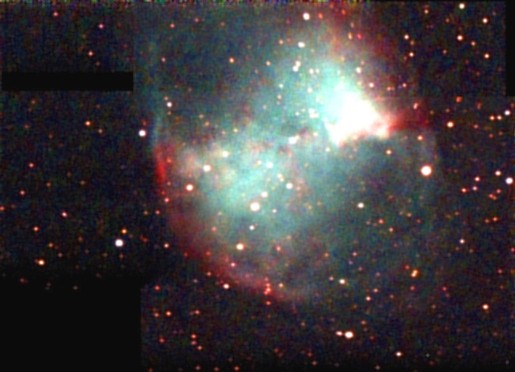
Subject: dsi ii color image Sent: Sunday, November 12, 2006 15:18:08 From: Steve (bullfox@comcast.net) This is the only usable image I have been able to get so far using the DSI II color camera and my 8 SC LXD55. Its about 1/8 to 1/4 mile distance. The image is partially processed in Autostar image processing and Paint Shop Pro.I consider myself fairly mechanically minded, but I find there is quite a learning curve with the whole set up from the goto mount, to the imager, and image processing, but if this images truly shows what can be done, I have to admit to being very pleased. Unfortunately, there has not been any clear night time weather since I figured out how to get the imager to work! Thanks for recommending the Meade imager over the Orion imager The mount is still pretty noisy after the hypertune, but it continues to run smoother and quieter the more I use it. With the 40 mm Pelosi the goto gets the target within in the field of view about a quarter of the time and rarely misses the findersocpe. This is quite and improvement over the first time I used it a couple of years ago when it wound up pointing at China!
Subject: ETX-125 DSI Comet Swan and more... Sent: Wednesday, November 8, 2006 21:14:58 From: Kevink (spunkyk98@wi.rr.com) some fair weather for October skies made me take out the ETX-125(mounted on a LXD75 mount) and DSI-C(with scopetronics field doubler) for some picture taking. Each picture has been unsharp masked, curves to make the background darker, saturation was adjusted, and then captioned and resized using Photoshop. Comet Swan on 2 nights... kevin (from 9 Nov)
Hope you enjoy the pics, it's been great using the ETX-125 on top of the LXD75 mount. Clear skies! Kevin
And:
let me say thanks for the Mighty ETX Site! It has been a mind boggling wealth of information for the ETX scopes. I recently upgraded now to a 8" LX-10 OTA for my LXD75 mount. So, I won't be using the ETX-125 anymore. I'll need to sell it to help pay for the new mount and OTA. Most of this last summer was spent visual observing, but in October, the skies and weather are perfect for capturing some pictures of star clusters. So, here are the last of my October pics using the ETX-125 and the DSI-C with the Scopetronics field doubler. Each photo was adjusted in photoshop to reduce background and to sharpen the stars... Enjoy, Clear Skies! Kevin
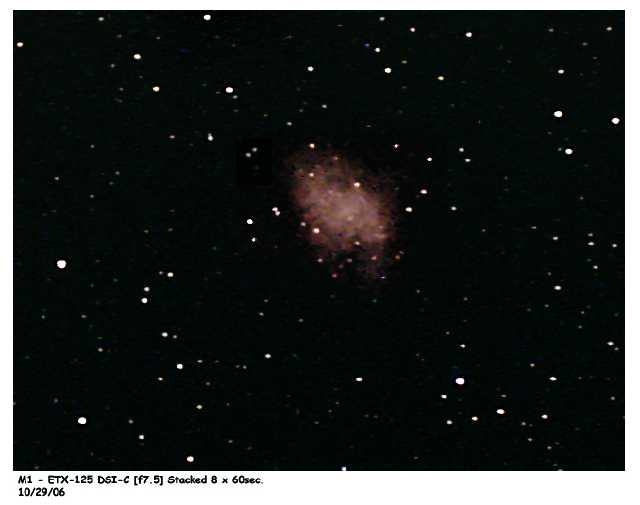
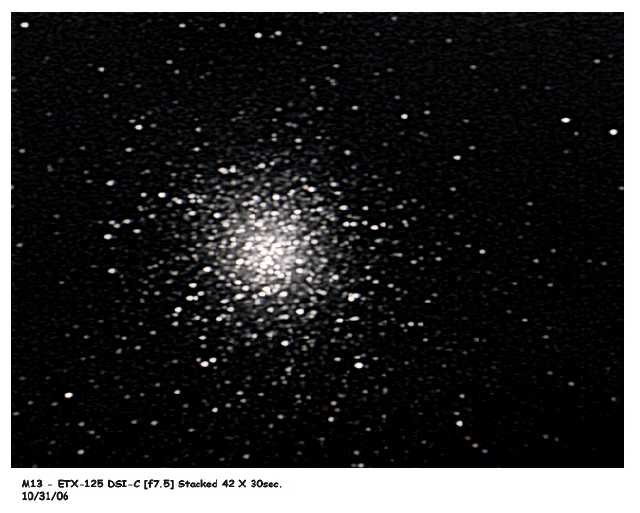
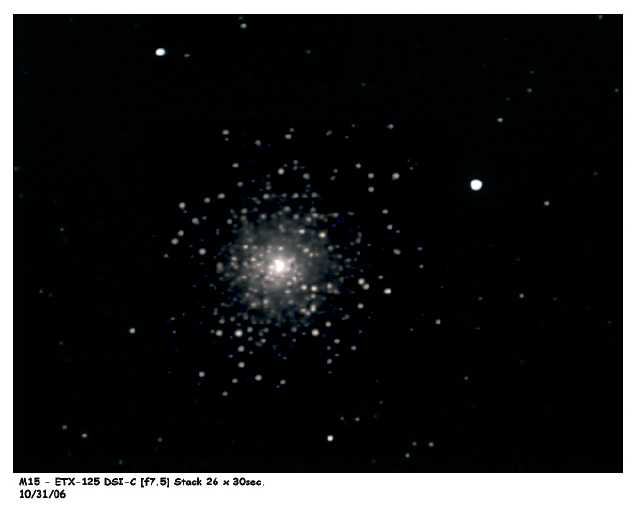
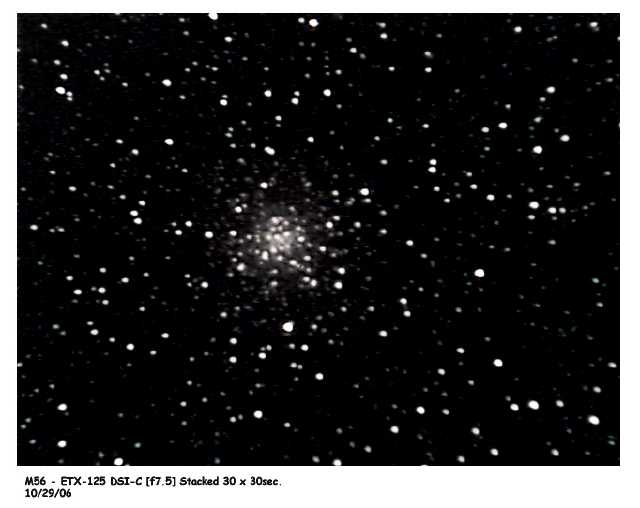
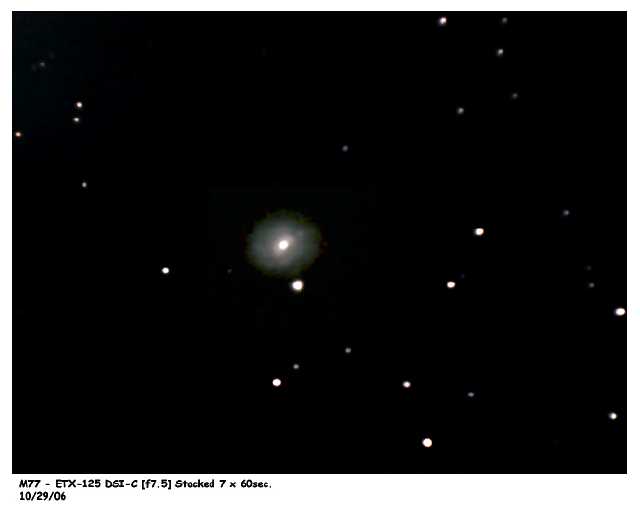
Subject: orion nebula etx80at Sent: Sunday, November 5, 2006 03:17:07 From: MARIA WESLEY (mariawesley@btinternet.com) please tell me if i can get a mini wedge for the etx80at? taken image of orion nebula last night 5th nov. i used single shot set at 30sec on the dsi camera.would like to try etx on a wedge and take longer images. ive attach images my first ever taken feel free to have good laugh. when bonfire smoke dies down im ging to try dsi with my lx90. clear skies maria
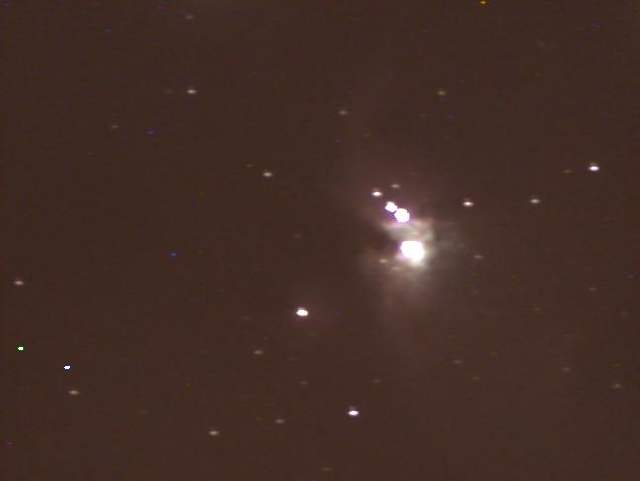
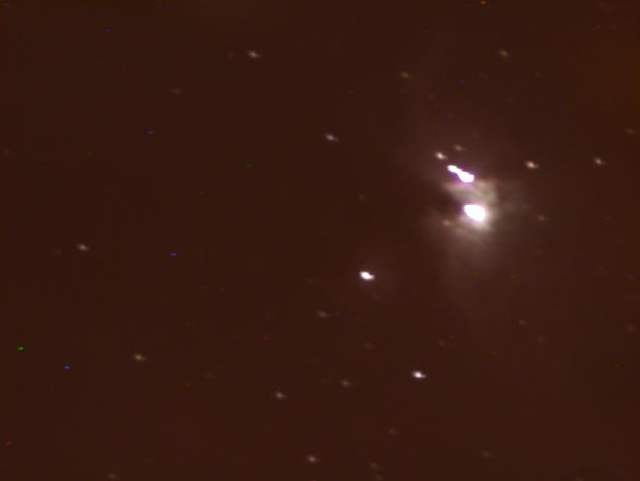
Subject: Meade DSI Sent: Thursday, October 26, 2006 16:28:10 From: Michael Caldwell (michael@cloudynights.co.uk) I am wondering whether any of your readers can explain why my DSI will not work properly for exposures 1 sec and above, It has been working fine for over a year but now when trying exposures 1 sec and more I always get an image as attached. It seems to image alright for exposures under 1 sec. Many thanks for your site Michael Caldwell
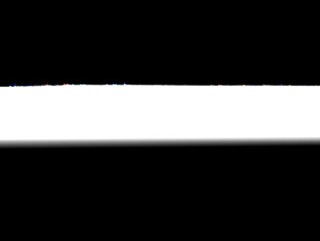
Subject: Harvest Moon with ETX-125 and DSI Sent: Sunday, October 8, 2006 20:17:47 From: spunkyk98 (spunkyk98@wi.rr.com) I can usually count on clear skies when the moon is full. I haven't taken any pictures of the moon yet with the ETX-125/DSI combo so I wanted to get a pic of the Harvest moon this month. I also tested out the DSI with a make-shift Afocal setup. I wondered if the DSI would actually capture what your seeing through a 40mm eyepiece. I tested out this Afocal setup by using a 40mm eyepiece attached to the DSI using some parts lying around from an ill-fated attempt at a cookbook CCD camera. At first it worked great, I was able to focus without any problems. Here's a 1 second exposure of Altair using this setup...As you can see, there is some ghosting. The real problem with this setup was trying to take longer exposures. I tried taking a 10 second preview pic and all I got was a bright halo in the middle of the frame. I didn't save any of the longer exposure preview pics. All-in-all, I scrapped the testing for this setup. I don't think this is even a 40mm field of view, looks more like what I'm seeing through a 26mm eyepiece. It was then time to take some moon pics. At this time the moon was high enough in the sky for DSI targeting. I used the DSI and the Scopetronix Field Doubler for the pics. I could only get a quarter of the moon in each frame. So I took 9 pics of each section of the moon and put them all together in Photoshop to give the appearance of a one-shot full moon frame...
This actually worked out well. I will be experimenting with this technique with the Pleiades this month. The Pleiades will be a good target since the field of view(even with the field doubler) is too small to get the whole cluster in one frame. I have tried on several occassions using drizzle to take a wider field pic, but I never got that to work well at all. Well that's it for now, clear skies! Thanks, Kevin
Subject: DSI IMAGER PRO 11 NO IMAGE Sent: Sunday, September 24, 2006 14:23:09 From: Ed Williams (hotstrings1@knology.net) Thanks so much for you site. Maybe you or someone else can help. I bought a DSI imager11 could not get image-sent it back for another because Thousand Oaks said they thought it was bad when I described the results. Received second DSI imager11 one pass colorsame problem 3 times with Meade and two times with Thousand Oaks they said it must be bad RETURN. They talked me into a DSI imager pro11 with the filters, ( which is what I did not want to begin with) received same thing. Talked to Meade he said have patience fine focus. I have run my laptop battery down 4 times now trying focus on pole in daylight trying a 24mm, 9mm,(on there recommendation) 10mm, etc no results. I am dying here. What I get on the screen is horizontal lines in sort of columns usually black w/ white lines then the only other thing is the screen might turn lighter but still with the lines. It makes no difference what the magic focus says. I have played with the gain and offset to no avail. I have tried this on my brand new HP m7480 pc and also my new hp media center laptop with of course 2. usb. WHAT THE HECK IS GOING ON? I feel like a fool sending this one back and wonder if it is windowsxp . I turned off the anti-virus and tried changing the screen res. Nothing. Please help. Thanks, Ed
Subject: DSI - "Draw a Box" query Sent: Wednesday, September 13, 2006 06:11:51 From: Niall J. Saunders (niall@njs101.com) Depending on which version of Meade software you are using to talk to your DSI, there are two instance when you can 'draw a box'. Because the upgrade is free, I don't really see why you should still be using the original software - the latest version - mine is v5.85 - is well worth the upgrade effort. In the original software you could use the mouse to 'draw a box' around a selected object and this would then be used as the reference for the internal 'combine and stacking' algorithm. You can only 'create' the box when you are looking at the 'live' image tab. If you already have a box created, then a subsequent mouse-click on the live image would 'clear' the previously created box. The later versions of the software - those that offer the 'drizzle' function - allow you to select a second target, and draw a box around that as well. The two boxes are then shown on-screen with a line linking them. Now, when images are stacked and combined, the Envisage software will try to de-rotate subsequent images in order to match the initial image in the stacking process. Again, to clear any created boxes, simply click one further time on the 'live' image tab. So far, the press described requires NO CONNECTION between the PC and the Autostar. However, if you DO have an (operational) RS-232 connection then, by choosing the 'Telescope' tab (next to the 'Stats' tab at the left of the Envisage window) you can also invoke the Envisage 'Guiding' commands. Initially you will want to ensure that the 'Will Cal / No Cal' option button is set to 'Will Cal' and then you can click the 'Guide Here' button. (see below if you only see a 'Track Here' button). You will also want to set the gain to somewhere between 0.5 and 1.0 - initially, you could leave it at 0.5 and see how things go, but with a high end PC and a well-behaved scope mount, I can get the best results using about 0.8 -0.9. If you KNOW what your effective FL is, accurately, then you should enter that for the best results. With the correct parameters defined, and with a target 'drawn-box' established, you can click the 'Guide Here' button - and WAIT. Envisage will work out, for itself, what it needs to do to get the 'guide star' to move E-W and N-S on the CCD chip. You don't need to worry about reversing button action in he Autostar menu, or whether you are or are not using a diagonal etc. Envisage will sort itself out. Eventually, Envisage will change the 'Will Cal' button to 'No Cal', and the 'Guide Here' to 'Stop Guiding' (or something similar, I don't have my DSI attached, so cannot verify the exact wording). This will also be accompanied by the appearance of a yellow circle, with yellow cross-hairs. This is the 'target' box, and all further Envisage commands issued to the Autostar will have the effect of trying to get the crosshairs of the 'drawn-box' (red box with green cross hairs, representing the 'brightest' pixel in the box) to appear at the same location as the yellow 'target' crosshairs. If you now click the 'Set Target' button, THEN click somewhere on the live image window, the yellow target icon will be moved to where you clicked, and Envisage will send commands via the Autostar to move the OTA such that the 'drawn box' ends up in the same place as the yellow target. Similarly, when you click the 'Center Target', the OTA will be moved to bring the 'drawn box' to the very centre of the CCD imager. This is exactly what you would want to happen if you wanted to perform a 'perfect' SYNC to Object - for example, during the Alignment procedure, or when using High Precision (by the way, when using any imager, I THOROUGHLY recommend enabling High Precision - it makes like SO much easier, and gives you a target to confirm that your focusing is still accurate). Now, the downside - if your scope is 'sloppy', or your training has not been carried out well enough, or your Backlash Percentages have not been tweaked, or you haven't recently done a Calibrate Motors, then you may find that you just can't get the OTA to 'chase' the little yellow target icon. Basically, if you cannot get your scope to 'behave' when you use x1 Guide Speed, then you are going to be less than likely to be able to get Guiding to work. If you CAN get the OTA to do EXACTLY what you want at the slowest control speed on the Autostar, but you still can't get good results from the Guiding section of Envisage, then you may need to give serious thought to the spec of the attached PC. I have a 400MHz P-II, with 512MB of RAM (running XP Pro SP2) and this is HOPELESS for using a DSI. It just takes TOO LONG to get each image processed (up to 30 seconds per exposure, irrespective of exposure length) and that is AFTER we upgraded the PC to USB2.0. In fact, the LOWEST spec PC that I am prepared to work with is a Pentium-M 1.2GHz, again with 512MB RAM (same XP and USB2.0). This has an overhead of 1 to 2 seconds per exposure. Manageable, but still not 'fluid' when trying to do things like PEC training etc. where the actual exposure time is in very small fractions of a second. My favourite PC for working with the DSI - this one, with a 3.6GHz Pentium P-4, and 2GB of DDR-2 RAM. There is NO appreciable lag, and images seem to 'stream in' with no real time lag between images. Certainly 3-5 images (FITS, no compression, colour) per second is easily achieved. Finally, a brief reprise of the difference between 'Track Here' and 'Guide Here'. As far as I am aware, the Guide Here option is only available if you have a DSI connected (not an LPI) and if your scope is Polar Mounted (or has a Dick Seymour 'patch-kit' installed in the Autostar. That said, I have never experimented to see what can, and cannot, be done if you only have the 'Track Here' option being shown. In any case, I hope these jottings and ramblings help. Regards, Niall Saunders Clinterty Observatories Aberdeen, SCOTLAND
And:
From: R.L. Creedon (creedon@cablespeed.com) You've done it again ! Us electronic cripples need all the help we can get. Thanks yet again. Lew Creedon
Subject: DSI Sent: Saturday, September 9, 2006 11:35:45 From: R.L. Creedon (creedon@cablespeed.com) Sorry to bother you again but you have turned out to be the only reliable help. Does the "draw a box" only function when the rs232 connection is made? I havn't tried that yet but get an occasional box on the screen for no reason I can perceive. Nobody says what controls instigate the "draw a box " function. Thanks again for all your help. Lew Creedon.Mike here: I haven't used that so can't say for certain. But if that is the same as the "spiral search", then yes, it would need to talk to the AutoStar. If that is something for the stacking process, then I wouldn't think the serial line needs to be active.
Subject: cables Sent: Saturday, September 2, 2006 18:19:53 From: R.L. Creedon (creedon@cablespeed.com) As an additional piece of experience you should know that during the course of these discoveries I have destroyed a focusing & a usb cable by simply rotating the vertical axis. It's very dark here !!! Lew Creedon.Mike here: Bummer. Perhaps adding some luminescent tape would help...
Subject: Installing DSI Pro Sent: Saturday, September 2, 2006 03:25:33 From: Jan H Kolst (jan.kolsto@online.no) I've installed Autostar suite for my LPI on my pc.I'm soon getting my DSI Pro.What do I have to do to use my DSI Pro?Just connect the DSI to my computer and install drivers from the Autostar suite? Or do I have to reinstall Autostar suite? Appreciate some advice on this issue. By the way I have come to terms with OPT and they have treated me very nicely after having some trouble with my new ETX 125 which I bought 8 months ago.So in the future I'll recommend OPT to anybody.They(Rayna and Emily at OPT) really treat customers decently,even abroad. That's my experience.Thanks a lot. Regards Jan H Kolst NorwayMike here: Glad to hear that things have worked out. As to the DSI, you shouldn't need to reinstall the AutoStar Suite; just connect the imager to a powered USB 2.0 port. The CD-ROM that comes with the DSI should have any drivers you might need.
Go to the June-August 2006 DSI Page.
Go to the May 2006 DSI Page.
Go to the March-April 2006 DSI Page.
Go to the January-February 2006 DSI Page.
Go to the November-December 2005 DSI Page.
Go to the October 2005 DSI Page.
Go to the August-September 2005 DSI Page.
Go to the June-July 2005 DSI Page.
Go to the May 2005 DSI Page.
Go to the March-April 2005 DSI Page.
Go to the January-February 2005 DSI Page.
Go to the 2004 DSI Page.
Go back to the Astrophotography Page.
Go back to my ETX Home Page.